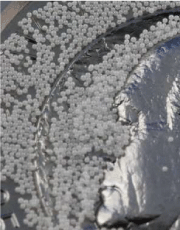E-Archive
Good Vibrations
in Vol. 22 - January Issue - Year 2021
New Process To Finish Coining Dies With Relief – For The Mint Industry

Picture 1

Picture 2

Picture 3

Picture 4

Picture 5

Picture 6
It is not so easy to leave out the word Covid19 in any kind of circumstances - in any kind of industry…
Because financial and industrial uncertainty came along with Covid19, society recognized an instability in the stock market. One of the typical reactions is that precious metal demands are rising.
Gold and Silver investments took and still take place in large values…
For the manufacturer of precious metal coins and medals, it has been challenging in 2020 in terms of keeping up with production.
Manufacturing of precious metal coins reflects a complex technology.
Producing a bullion coin of fine silver (Ag999) involves casting, precision strip rolling, blanking, rimming, weight adjustment, surface finishing, coining, possibly coloring and finally packing!
A large task in manufacturing the coin itself is to design the coin – done by art workers. A piece of metal (called blank) only becomes a coin after coining.
The coining step is carried out by a coining press, using coining dies. The dies and the press force will let the material flow until the coin appears in its perfect condition.
The coining die and its quality including design is the main tool to let the coin become an attractive collector item. (Picture 1)
Hard or soft steel and different materials can be chosen to produce a coining die. Different diameters for different coin sizes reflect a large variety of coining dies.
The first manufacturing step of a die is done in different ways: laser engraving and milling. For master dies, milling is the only method to manufacture a die, known for its flexibility and precision at the same time.
The very small tools (down to 0,1mm in diameter) will complete their task between 6 and 12 hours per die. E.g., for a 39mm die as shown above, the milling time is about 12h. The signature of the tool is visible, seen as circles around the diameter of the die. (Picture 2)
These grooves are removed with great effort manually – it takes a lot of laborious hours and experience to “refinish” this condition.
Research has been carried out between Spaleck Oberflächentechnik GmbH & CoKG and the Mint of Norway, located in Kongsberg, to reduce the labor costs.
As a result of the study, an automated process was taken into consideration whereby the dies (soft or hard) can undergo a surface finishing process where a smoothing operation will smooth the table of the die without attacking the relief in its details.
The concept of the machine (Pictures 3 & 4) is based on centrifugal force. A rotating working chamber, filled with media small enough to reach all relief details, will create a work force against the die surfaces. While the dies are placed in a holding arm (up to five dies per arm, up to 4 arms) they are rotating around their own axles as well.
The working chamber operates throughout the finishing cycle (60 to 90 minutes) with different compounds and pastes, supporting both smoothing and polishing procedures. Due to the adjustable rotating speed, the media may act between “intensive and smooth” against the surface to be finished.
The final finishing results are reproducible, which is one of the advantages compared to the manual labor carried out currently in many Mints around the world.
The small ceramic finishing media has defined characteristics – perfect to be used to reach into the small areas of the die surface. (Picture 5)
The comparison between “before and after” reflects the results achieved during the finishing cycle – picture 6
Very little, or no shadows around the letters have occurred – thus, no manual retreatment is necessary after the surface finishing process.
The dies are ready for production now, unless they undergo further design treatments – ready to please the collector market demands.
(The rights of the photographs belong to Mr. Øivind Hansen's licensees (1949 – 1986 Chief Engraver at the Royal Norwegian Mint ) – permission by Mr Torbjörn Hansen
Good Vibrations
by Thomas Hogenkamp
Contributing Editor MFN and
Sales Director, Spaleck
Oberflächentechnik GmbH
Germany
Tel. + 49.2871.9500.14
E-mail: thomas@mfn.li



























